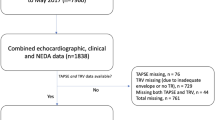Abstract
In post-operative Tetralogy of Fallot (TOF) patients cMRI data are used for determining right ventricle (RV) dilation to justify the pulmonary valve placement. Echocardiogram analysis of RV volumes has inherent accuracy issues. There are no data exploring the relationship of transthoracic echocardiography tricuspid valve (TV) annulus size and cMRI RV dilation. Retrospective study in post-operative TOF patients. Patients less than 21 years old and with high-quality transthoracic echocardiogram and MRI within 6 months of each other were included. We collected demographic data, type of initial repair, echocardiographic, and cMRI data. A single reviewer measured echocardiogram TV size. Boston z-scores were used. 77 echocardiogram and cMRI pairs were analyzed. Average age was 14 years old. There is not a strong linear relationship between TV z-score and indexed right ventricular end diastolic volume (RVEDVi) (R2 = 0.31). Twenty patients had RVEDVi’s of greater than 150 ml/m2. From those 20 patients, 9 patients had a TV z-score of > 2. No patient had a TV z-score > 2 and a normal RVEDVi. For a TV z-score < 2, there was a positive predictive value of 100%, a negative predictive value of 83%, specificity of 100%, and sensitivity of 45%. In our study population, the TV z-score is not sufficient to predict RV dilation. However, TV z-score > 2 has a high positive predictive value for an RVEDVi of > 150 ml/m2. This would suggest that a cMRI should be done if the TV z-score is > 2 on echocardiography.



Similar content being viewed by others
Data Availability
Not applicable.
Code Availability
Not applicable.
References
Geva T (2011) Repaired tetralogy of Fallot: the roles of cardiovascular magnetic resonance in evaluating pathophysiology and for pulmonary valve replacement decision support. J Cardiovasc Magn Reson. https://doi.org/10.1186/1532-429x-13-9
Alvarez-Fuente M, Garrido-Lestache E, Fernandez-Pineda L et al (2015) Timing of pulmonary valve replacement: how much can the right ventricle dilate before it looses its remodeling potential? Pediatr Cardiol 37(3):601–605. https://doi.org/10.1007/s00246-015-1320-4
Villafañe J, Feinstein JA, Jenkins KJ et al (2013) Hot topics in tetralogy of Fallot. J Am Coll Cardiol. https://doi.org/10.1016/j.jacc.2013.07.100
Stout K et al (2018) AHA/ACC guideline for the management of adults with congenital heart disease: a report of the American College of Cardiology/American Heart Association Task Force on clinical practice guidelines. Circulation 139(14):698–800
Buechel ERV, Dave HH, Kellenberger CJ et al (2005) Remodelling of the right ventricle after early pulmonary valve replacement in children with repaired tetralogy of Fallot: assessment by cardiovascular magnetic resonance. Eur Heart J 26(24):2721–2727. https://doi.org/10.1093/eurheartj/ehi581
Crean A, Ballard G, Maredia N, Greenwood J, Thomson J (2010) 3D echo systematically underestimates right ventricular volume compared to cardiac magnetic resonance in a population with adult congenital heart disease. J Cardiovasc Magn Reson. https://doi.org/10.1186/1532-429x-12-s1-p18
Selly J-B, Iriart X, Roubertie F et al (2015) Multivariable assessment of the right ventricle by echocardiography in patients with repaired tetralogy of Fallot undergoing pulmonary valve replacement: a comparative study with magnetic resonance imaging. Arch Cardiovasc Dis 108(1):5–15. https://doi.org/10.1016/j.acvd.2014.07.054
Koestenberger M, Nagel B, Ravekes W et al (2010) Tricuspid annular plane systolic excursion and right ventricular ejection fraction in pediatric and adolescent patients with tetralogy of Fallot, patients with atrial septal defect, and age-matched normal subjects. Clin Res Cardiol 100(1):67–75. https://doi.org/10.1007/s00392-010-0213-z
Zhao H, Kang Y, Pickle J, Wang J, Han Y (2019) Tricuspid annular plane systolic excursion is dependent on right ventricular volume in addition to function. Echocardiography 36(8):1459–1466. https://doi.org/10.1111/echo.14439
Zakaria D, Lang S, Bolin E, Gossett J, Rettiganti MR, Collins T (2017) Short axis diastolic ventricular area ratio as a new index in screening patients with repaired tetralogy Of Fallot. J Am Coll Cardiol 69(11):644. https://doi.org/10.1016/s0735-1097(17)34033-0
Acknowledgements
This project was supported in part by the National Institutes of Health through Grant Number UL1-TR-001857.
Funding
Not applicable.
Author information
Authors and Affiliations
Corresponding author
Ethics declarations
Conflict of interest
Not applicable.
Consent to Participation
Not applicable.
Consent for Publications
Yes.
Ethical Approval
UPMC IRB approved.
Additional information
Publisher's Note
Springer Nature remains neutral with regard to jurisdictional claims in published maps and institutional affiliations.
Rights and permissions
About this article
Cite this article
Snyder, K., Drant, S., Carris, E. et al. Tricuspid Valve Size Relationship to Right Ventricular Volume in Post-operative Tetralogy of Fallot Patients. Pediatr Cardiol 43, 887–893 (2022). https://doi.org/10.1007/s00246-021-02800-0
Received:
Accepted:
Published:
Issue Date:
DOI: https://doi.org/10.1007/s00246-021-02800-0




